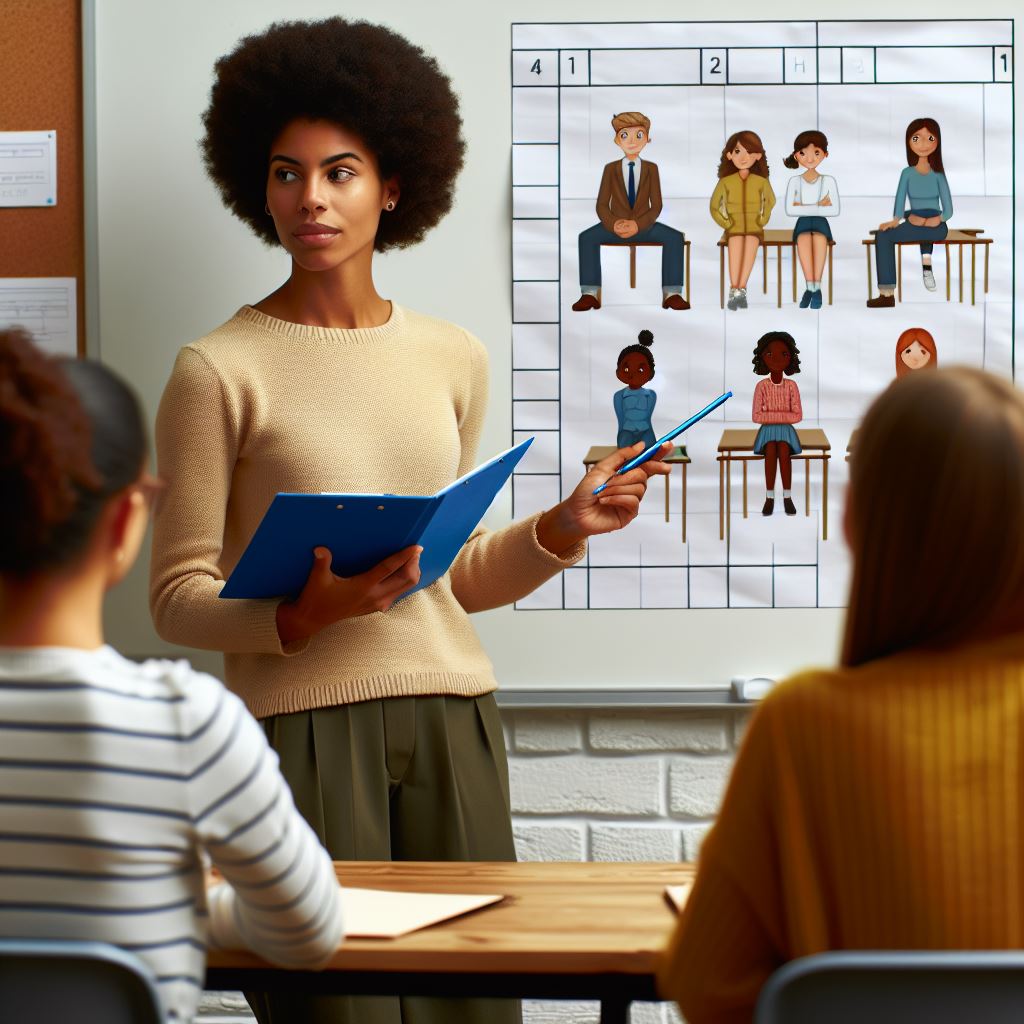Introduction
Classroom management is a crucial aspect of education that greatly impacts student learning and success.
As teachers, it is essential for us to effectively manage our classrooms to create a positive and conducive learning environment.
Seeking tips from Canadian experts in this field is valuable, as they possess a wealth of experience and expertise specific to our educational system.
These experts understand the unique challenges and best practices that are relevant to Canadian classrooms.
By leveraging their insights, we can enhance our classroom management skills and ultimately improve student outcomes.
Let us dive into the valuable tips shared by these Canadian experts to cultivate a positive learning environment for our students.
Overview of Classroom Management
In this section, we will explore the concept of classroom management and its significance in creating a positive learning environment.
We will also delve into the importance of effective classroom management in enhancing student engagement and academic performance.
A. What is Classroom Management?
- Classroom management refers to the techniques and strategies used by teachers to maintain discipline and promote a conducive learning atmosphere.
- It involves organizing the physical space, establishing routines, and implementing rules and procedures.
- Classroom management aims to create an environment where students feel safe, respected, and motivated to learn.
B. The Role of Classroom Management in Creating a Positive Learning Environment
- Effective classroom management fosters an environment that encourages active student participation and collaboration.
- It promotes a sense of belonging and cooperation among students, leading to improved social and emotional development.
- When students feel supported and engaged in the classroom, they are more likely to succeed academically.
C. The Importance of Effective Classroom Management in Enhancing Student Engagement and Academic Performance
- Well-managed classrooms provide clear expectations and guidelines, allowing students to focus on their learning goals.
- Teachers who implement effective classroom management strategies can effectively control disruptive behavior and minimize distractions.
- By establishing a positive classroom climate, with consistent rules and consequences, students are motivated to actively participate in lessons.
- Enhanced student engagement leads to a deeper understanding of the subject matter and improved academic performance.
D. Key Elements of Effective Classroom Management
Effective classroom management involves the following key elements:
- Establishing clear expectations and goals: Clearly communicate the behavior and academic standards expected from students.
- Building positive relationships: Develop a rapport with students through respect, empathy, and understanding.
- Creating a well-structured environment: Organize the physical space and establish consistent routines to minimize disruptions.
- Implementing proactive strategies: Use preventive measures such as positive reinforcement, engaging lessons, and differentiated instruction.
- Addressing behavioral issues promptly: Respond promptly and consistently to disruptive behavior, utilizing appropriate consequences.
- Encouraging student autonomy: Foster independence and decision-making skills by giving students some control over their learning.
- Continuously reflecting and adapting: Regularly assess and adjust classroom management strategies based on student needs and feedback.
Effective classroom management plays a vital role in creating a positive learning environment and enhancing student engagement and academic performance.
By implementing strategies that establish clear expectations, build positive relationships, and create a well-structured environment, teachers can foster a supportive atmosphere where students thrive.
Read: Retirement Planning for Canadian Professors
Establishing Clear Expectations
Setting clear expectations for student behavior and academic achievement is essential for a well-managed classroom.
When students know what is expected of them, they are more likely to meet those expectations and succeed academically.
A. Significance of setting clear expectations
Establishing clear expectations helps create a positive learning environment where students feel safe and supported.
When students know what is acceptable behavior and what is not, they can focus on their learning without distractions.
Clear expectations also promote fairness and consistency in the classroom, preventing misunderstandings and conflicts.
Furthermore, clear expectations have a direct impact on students’ academic achievement.
When students understand what is expected of them academically, they know the standards they need to meet and the skills they need to develop.
This clarity empowers students to take ownership of their learning and strive to excel in their studies.
B. Classroom rules and procedures recommended by Canadian experts
- Respect each other’s ideas and opinions
- Listen actively when others are speaking
- Be prepared with all necessary materials
- Submit assignments on time
- Follow directions the first time they are given
- Raise your hand to speak or ask a question
- Keep all electronic devices silenced and put away during class
These specific rules and procedures help create a structured and respectful learning environment, ensuring that students are focused on their studies and treating each other with kindness and respect.
C. Effectively communicating expectations to students
To effectively communicate expectations, it is important to clearly explain each rule and procedure to the students.
Use examples and non-examples to illustrate the behavior that is expected.
Encourage students to ask questions and seek clarification if they are unsure about any expectations.
Involving students in the process of establishing expectations can also increase their sense of ownership and commitment.
Hold class discussions to brainstorm and generate ideas for rules and procedures.
Ask students for their input and let them contribute to the decision-making process.
This involvement helps students feel valued and respected, leading to a stronger adherence to the established expectations.
Additionally, it is crucial to consistently reinforce the expectations through reminders and positive reinforcement.
Regularly review the rules and procedures and provide specific feedback when students meet or exceed the expectations.
Celebrate their successes and acknowledge their efforts, creating a positive and supportive classroom climate.
In fact, establishing clear expectations for student behavior and academic achievement is crucial for effective classroom management.
By setting specific rules and procedures, effectively communicating them to students, and involving them in the process, educators can create a positive and productive learning environment that promotes success for all students.
Read: The Future of Professorship in Canada
Building Positive Relationships
Building strong and positive teacher-student relationships is an essential aspect of effective classroom management.
These relationships are crucial as they not only enhance student engagement but also contribute to a positive learning environment.
A. The Importance of Building Strong and Positive Teacher-Student Relationships
Positive teacher-student relationships have a significant impact on student behavior and academic performance.
When students feel valued, respected, and connected to their teachers, they are more likely to be motivated, behave appropriately, and actively participate in class.
Research has consistently shown that positive relationships reduce disciplinary issues and improve classroom dynamics.
By fostering a positive rapport, teachers can create a safe and supportive environment that encourages students to take risks, ask questions, and collaborate with their peers.
B. How Positive Relationships Contribute to Better Classroom Management
Effective classroom management relies on mutual trust and respect between teacher and student.
When teachers build positive relationships with their students, they establish a foundation of trust, making it easier to address problematic behaviors and implement effective discipline strategies.
Students are more likely to follow rules and guidelines when they believe their teacher genuinely cares about their well-being and success.
These positive relationships can help prevent potential disruptions, minimize conflicts, and promote a positive classroom climate.
C. Canadian Experts’ Suggestions on Fostering Positive Relationships
Canadian education experts have shared valuable tips on how teachers can foster positive relationships with their students:
- Active Listening: Actively listen to students, validate their feelings, and show genuine interest in their thoughts and experiences. This helps build trust and understanding.
- Empathy: Show empathy towards students’ struggles and challenges. Understanding their unique backgrounds and experiences enhances the teacher-student connection.
- Personalized Interactions: Take the time to get to know each student individually. Recognize their strengths, interests, and learning styles, and adapt your teaching strategies accordingly.
- Mutual Respect: Treat every student with respect and fairness. Create a supportive classroom culture where differences are celebrated and everyone feels included.
- Effective Communication: Establish open lines of communication with students. Regularly provide constructive feedback, listen to their suggestions, and involve them in decision-making processes.
- Positive Reinforcement: Acknowledge and appreciate students’ efforts and achievements. Recognize their progress publicly, which boosts their self-esteem and strengthens the teacher-student bond.
- Conflict Resolution: Teach and model effective conflict resolution strategies. Help students develop the skills needed to handle disagreements respectfully and find peaceful resolutions.
By incorporating these suggestions into their daily practices, teachers can actively build positive relationships with their students, leading to better classroom management outcomes.
In short, fostering positive teacher-student relationships is an integral part of classroom management.
By prioritizing active listening, empathy, and personalized interactions, Canadian experts emphasize the importance of creating a supportive and inclusive learning environment.
These positive relationships help students feel valued and connected, resulting in improved behavior, engagement, and overall academic success.
Read: Balancing Work and Life as a Professor

Reinforcing Positive Behavior
A. Use of positive reinforcement techniques in classroom management
Positive reinforcement techniques play a crucial role in effective classroom management.
Canadian experts recommend various strategies that can be employed to reinforce positive behavior in students.
These techniques include verbal praise, rewards, and recognition.
1. Verbal praise
Verbal praise is a powerful tool that can be used to acknowledge and encourage positive behavior in the classroom.
Teachers can provide specific and genuine compliments to students when they demonstrate the desired behaviors.
For example, a teacher might say, “Great job, Sarah! I noticed how you helped your classmates during group work.”
Unlock Your Career Potential
Visualize a clear path to success with our tailored Career Consulting service. Personalized insights in just 1-3 days.
Get Started2. Rewards
Rewards can also be used to reinforce positive behavior.
These can range from simple incentives like stickers or small treats to larger rewards such as extra free time or special privileges.
When students consistently exhibit positive behaviors, they can be rewarded accordingly.
This not only motivates students but also reinforces the importance of good behavior.
3. Recognition
Recognition is another effective strategy recommended by Canadian experts.
Students appreciate being recognized for their efforts and achievements.
Teachers can publicly acknowledge and applaud students who consistently display positive behaviors.
This could be done through certificates, classroom displays, or verbal recognition during class meetings.
By acknowledging students in front of their peers, teachers create a positive classroom culture where good behavior is valued and celebrated.
B. Benefits of positive reinforcement in motivating students and maintaining a positive classroom atmosphere
Positive reinforcement techniques offer several benefits in motivating students and maintaining a positive classroom atmosphere.
Firstly, they encourage students to repeat desired behaviors.
When positive behavior is consistently reinforced, students feel a sense of accomplishment and are more likely to continue displaying those behaviors in the future.
Secondly, positive reinforcement helps build students’ self-esteem and self-confidence.
When students receive verbal praise or other forms of recognition, they feel valued and appreciated.
This boosts their self-esteem and motivates them to keep engaging in positive behaviors.
Moreover, positive reinforcement fosters a positive classroom environment.
By focusing on positive behaviors, teachers create a welcoming and supportive atmosphere where students are more willing to participate and take risks.
This, in turn, improves academic performance and overall classroom dynamics.
Additionally, positive reinforcement helps establish strong teacher-student relationships.
When teachers consistently acknowledge and reward positive behavior, students develop a sense of trust and respect for their teachers.
This positive rapport enables better communication and collaboration in the classroom.
In essence, reinforcing positive behavior is vital in effective classroom management.
By using strategies such as verbal praise, rewards, and recognition, teachers can motivate students and maintain a positive classroom atmosphere.
Positive reinforcement not only encourages desired behaviors but also promotes self-esteem, fosters a positive environment, and strengthens teacher-student relationships.
Read: Canadian Teaching Certifications: A Step-by-Step
Addressing Misbehavior
In any classroom, there will inevitably be instances of misbehavior.
A. Effective strategies for addressing misbehavior in the classroom
It’s crucial for educators to be equipped with effective strategies to address these disruptive behaviors.
Canadian experts have shared their recommendations on how to handle challenging students while maintaining consistency, fairness, and respect.
Here are some valuable tips:
- Establish clear expectations: Clearly communicate your classroom rules and expectations to the students from the very beginning. Make sure they understand what is acceptable and what is not.
- Address misbehavior promptly: Deal with misbehavior as soon as it occurs to prevent it from escalating. Address the issue privately, if possible, to avoid embarrassing the student.
- Use positive reinforcement: Catch students being good and acknowledge their positive behavior.
Praising and rewarding students for their appropriate conduct creates a positive classroom environment. - Be consistent: Apply consequences consistently and equally to all students. Inconsistency can lead to confusion and a lack of respect for your authority.
- Set consequences: Establish a range of appropriate consequences for misbehavior.
Ensure they are fair and proportionate and let the students know what they can expect if they choose to misbehave. - Encourage self-reflection: Instead of just punitive actions, encourage students to reflect on their misbehavior and its impact on themselves and others. This can help them develop self-awareness and personal responsibility.
- Communicate with parents: Keep parents informed about their child’s behavior, both positive and negative. Building a partnership with parents can help address any underlying issues.
- Implement restorative practices: Consider adopting restorative practices, such as talking circles or conflict resolution, to address conflicts and build connections between students.
- Seek professional support: If the misbehavior persists or becomes severe, do not hesitate to seek guidance from your school’s guidance counselor or behavior specialist. They can provide additional strategies and interventions.
B. Importance of maintaining consistency, fairness, and respect when addressing misbehavior
While addressing misbehavior, it’s important to remember that every student is unique and may exhibit challenging behaviors for various reasons.
It is crucial to approach each case with empathy and an open mind, striving to understand the underlying causes of the misbehavior.
By responding with consistency, fairness, and respect, educators can create a safe and supportive learning environment for all students.
In general, addressing misbehavior is an essential aspect of classroom management.
By following these strategies, educators can effectively deal with disruptive or challenging students while maintaining a positive and inclusive learning environment.
Delve into the Subject: Counseling Techniques Popular in Canada
Engaging Instructional Strategies
A. How engaging instructional strategies can contribute to effective classroom management
Engaging instructional strategies play a vital role in effective classroom management.
By implementing these strategies, teachers can create an environment that fosters student engagement, motivation, and focus.
B. Canadian experts’ suggestions on using active learning, group work, technology, and other techniques
Canadian experts emphasize the importance of active learning as an engaging instructional strategy.
This approach moves away from the traditional lecture-style teaching and encourages students to be actively involved in the learning process.
Active learning techniques include group work, discussions, and hands-on activities.
Group work is often recommended by Canadian experts as it promotes collaboration and teamwork among students.
By assigning group projects or incorporating group discussions, teachers encourage students to interact, share ideas, and learn from one another.
This fosters a sense of engagement and active participation in the classroom.
The use of technology is another engaging strategy suggested by Canadian experts.
Integrating technology into lesson plans can capture students’ attention and make learning more interactive and enjoyable.
Tools such as interactive whiteboards, educational apps, and online resources provide new avenues for student engagement and can enhance their understanding of the subject matter.
C. Examples of engaging activities and teaching methods that help keep students motivated and focused
In addition to active learning and technology, Canadian experts suggest various other techniques to keep students motivated and focused.
These include:
- Incorporating real-life examples and applications: Connecting lessons to real-world scenarios helps students see the practical relevance of what they are learning, making it more meaningful and engaging.
- Using multimedia presentations: Integrating videos, images, and audio in presentations adds visual and auditory stimuli, creating a dynamic learning experience that captures students’ interest and aids in retention.
- Gamifying the learning experience: Incorporating game elements into the classroom, such as point systems, challenges, and rewards, can motivate students and make learning more enjoyable.
- Providing choice and autonomy: Allowing students to have a say in their learning process, such as selecting topics or project formats, promotes a sense of ownership and increases engagement.
- Using hands-on experiments and demonstrations: Providing opportunities for students to actively engage with the subject matter through experiments and demonstrations promotes learning through inquiry and discovery.
- Encouraging student reflections and self-assessment: Giving students space to reflect on their learning and assess their progress fosters metacognition and encourages them to take responsibility for their own learning.
By implementing these engaging instructional strategies, teachers can create a learning environment that promotes active participation, increases student motivation, and helps maintain focus.
By making learning relevant, interactive, and enjoyable, teachers can enhance classroom management and create an atmosphere conducive to productive learning.
Conclusion
Effective classroom management strategies are crucial for creating a positive learning environment.
Throughout this blog post, we have discussed various tips from Canadian experts that can greatly enhance your classroom management skills.
Firstly, we emphasized the significance of setting clear expectations and rules for your students.
By doing so, you establish a structured and orderly classroom atmosphere.
Secondly, we talked about the importance of building positive relationships with your students.
Developing a connection with them not only fosters engagement but also helps in effectively managing student behavior.
Additionally, we touched upon the significance of implementing effective communication techniques.
By effectively communicating with your students and parents, you can address any issues and maintain a supportive learning environment.
Furthermore, we stressed the importance of incorporating engaging and interactive activities into your lessons.
This not only keeps students interested but also minimizes behavioral issues.
Lastly, we discussed the benefits of using praise and rewards to reinforce positive behavior.
Acknowledging and rewarding students for their efforts and achievements helps to create a motivating atmosphere.
Employing these strategies will undoubtedly enhance your classroom management skills.
By implementing the tips provided by Canadian experts, you can create a more productive and enjoyable learning environment for both you and your students.
Overall, effective classroom management is essential for all educators.
By utilizing the valuable insights and recommendations from Canadian experts, you can significantly improve your classroom management skills.
Don’t hesitate to implement these tips and witness the positive impact they have on your teaching experience.




